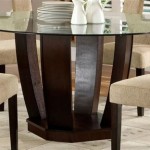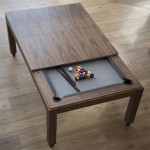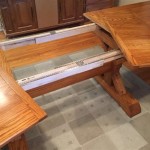Height of Dining Room Light Over Table: A Comprehensive Guide
The dining room is often considered the heart of the home, a space where families and friends gather to share meals, stories, and create memories. The lighting in this space plays a crucial role in setting the ambiance and functionality, and arguably, the height of the light fixture above the dining table is the most critical factor to consider. Incorrect placement can lead to glare, insufficient illumination, or an unbalanced visual aesthetic. Determining the proper height involves considering various elements, including the style of fixture, the dimensions of the table and room, and the desired atmosphere.
This article will provide a comprehensive guide to understanding and determining the optimal height for a dining room light fixture above the table. It will delve into the factors that influence this decision, addressing common misconceptions and offering practical advice to ensure a well-lit and visually appealing dining space.
Understanding Standard Height Guidelines
As a general rule, the bottom of a dining room light fixture should hang approximately 28 to 36 inches above the table surface. This measurement is based on a standard 8-foot ceiling height. The purpose of this range is to provide adequate illumination of the tabletop without obstructing the view across the table or creating a sensation of being too close to the light source. This height typically allows for comfortable conversation and prevents glare from directly shining into diners' eyes.
However, it is essential to recognize that this is merely a guideline, and adjustments may be necessary depending on specific circumstances. The height of the ceiling is a primary determinant, and a higher ceiling necessitates a higher placement of the light fixture. Conversely, in rooms with lower ceilings, a closer placement to the table may be required to maintain visual proportion and avoid overwhelming the space.
Additionally, the style and size of the fixture itself will impact the perceived hanging height. A large, ornate chandelier will visually take up more space than a smaller, minimalist pendant light, and therefore might require a slightly higher placement to avoid feeling imposing. Similarly, the shape and design of the tabletop can also influence the perceived height. A round table, for instance, will often feel more balanced with a slightly lower hanging light fixture compared to a long rectangular table, as the light will be more centrally located.
Adjusting Height Based on Ceiling Height
The 28- to 36-inch rule is a starting point for an 8-foot ceiling. For ceilings higher than 8 feet, the general recommendation is to add approximately 3 inches of height for each additional foot of ceiling height. This allows the light fixture to remain proportional to the room and prevents it from appearing lost in the vastness of the space.
For example, in a room with a 9-foot ceiling, the bottom of the light fixture should hang between 31 and 39 inches above the table. With a 10-foot ceiling, this range increases to 34 to 42 inches. These adjustments ensure that the light fixture remains a focal point of the room without feeling disproportionately small or being positioned too high to effectively illuminate the table.
In rooms with ceilings lower than 8 feet, careful consideration is required. In such cases, it may be necessary to reduce the hanging height below the standard 28-inch mark. However, it is crucial to avoid positioning the light fixture too close to the table, as this can lead to discomfort and obstruct the view. A shallower light fixture, such as a flush mount or semi-flush mount fixture, may be a more suitable option for rooms with low ceilings, as they minimize the vertical space occupied by the lighting.
When dealing with vaulted or sloped ceilings, the positioning of the light fixture can be particularly challenging. In such cases, it is recommended to hang the fixture at the lowest point of the ceiling, ensuring that it is centered over the table. The height should then be adjusted based on the overall dimensions of the room, taking into account the slope of the ceiling. If possible, adjustable cables or rods can be used to fine-tune the height and angle of the light fixture.
The Influence of Fixture Style and Table Dimensions
The style of the dining room light fixture significantly impacts the perceived height and overall aesthetic. A large chandelier, with its intricate design and multiple tiers, will visually occupy more space than a single pendant light. Therefore, a chandelier often requires a higher placement to avoid feeling overwhelming or obstructing the view. Conversely, a minimalist pendant light can be hung slightly lower without appearing intrusive.
The shape and size of the dining table are also important considerations. A round table typically benefits from a single, centrally positioned light fixture. In this case, the height should be adjusted to ensure that the light is evenly distributed across the entire tabletop. With a long, rectangular table, however, multiple pendant lights or a linear chandelier may be a more appropriate choice. In such cases, the height of each individual light fixture should be carefully calibrated to create a balanced and visually appealing effect. The spacing between the lights must also be considered to avoid creating dark spots or uneven illumination.
Furthermore, the material and opacity of the light fixture's shade can influence the required height. A light fixture with a translucent shade will emit more light and may require a slightly higher placement to avoid glare. Conversely, a fixture with an opaque shade will direct light downwards and may be hung slightly lower to maximize illumination of the tabletop. The color of the shade can also affect the perceived brightness and warmth of the light, which should be taken into account when determining the height.
The overall style of the dining room should also be considered. A formal dining room may benefit from a more elaborate chandelier hung at a slightly higher height to create a sense of grandeur. A more casual dining room might be better suited to a simpler pendant light hung at a lower height to create a more intimate atmosphere. The light fixture should complement the existing furniture and décor, and the height should be adjusted accordingly to achieve a harmonious and balanced visual composition.
Practical Considerations and Installation Tips
Before installing a dining room light fixture, it is advisable to temporarily hang the fixture at different heights to determine the optimal placement. This can be done by using a temporary support structure or by enlisting the help of a friend. Observing the light fixture at various heights from different vantage points in the room will provide valuable insights into how it affects the overall aesthetic and functionality of the space.
When installing the light fixture, ensure that all electrical connections are properly secured and that the fixture is securely mounted to the ceiling. If necessary, consult a qualified electrician to ensure that the installation is performed safely and in accordance with local building codes. It is also important to select appropriate light bulbs for the fixture, taking into account the desired brightness, color temperature, and energy efficiency. Dimmable light bulbs can be particularly useful in a dining room, as they allow for adjusting the light level to suit different occasions and moods.
Consider the weight of the light fixture when selecting a mounting system. Heavier fixtures may require additional support, such as a ceiling brace or a reinforced mounting plate. Ensure that the mounting system is capable of safely supporting the weight of the fixture and that it is properly installed to prevent the fixture from falling or becoming damaged.
Finally, remember that personal preference plays a significant role in determining the ideal height for a dining room light fixture. While the guidelines and recommendations provided in this article offer a solid foundation, the ultimate decision should be based on individual taste and the specific characteristics of the dining space. Experiment with different heights and lighting levels to find the optimal balance between functionality and aesthetics, creating a dining room that is both inviting and visually appealing.

Lighting Tips How To Light A Dining Area

10 Design Tips That This Girl Lives By

The Ultimate Guide To Pendant Lighting For A Cozy Home Delmarfans Com

The How To Lighting Guide Lightology

The Correct Height For Dining Room Lighting Lightbox

How To Hang A Chandelier At The Perfect Height Over Dining Table Mod Lighting

How To Size A Dining Room Chandelier 3 Easy Steps

Dining Room Lighting Ideas

How High Should You Hang Your Dining Room Chandelier Arched Manor

Guideline For Hanging Dining Room Pendant Lamps Seeddesign Usa








